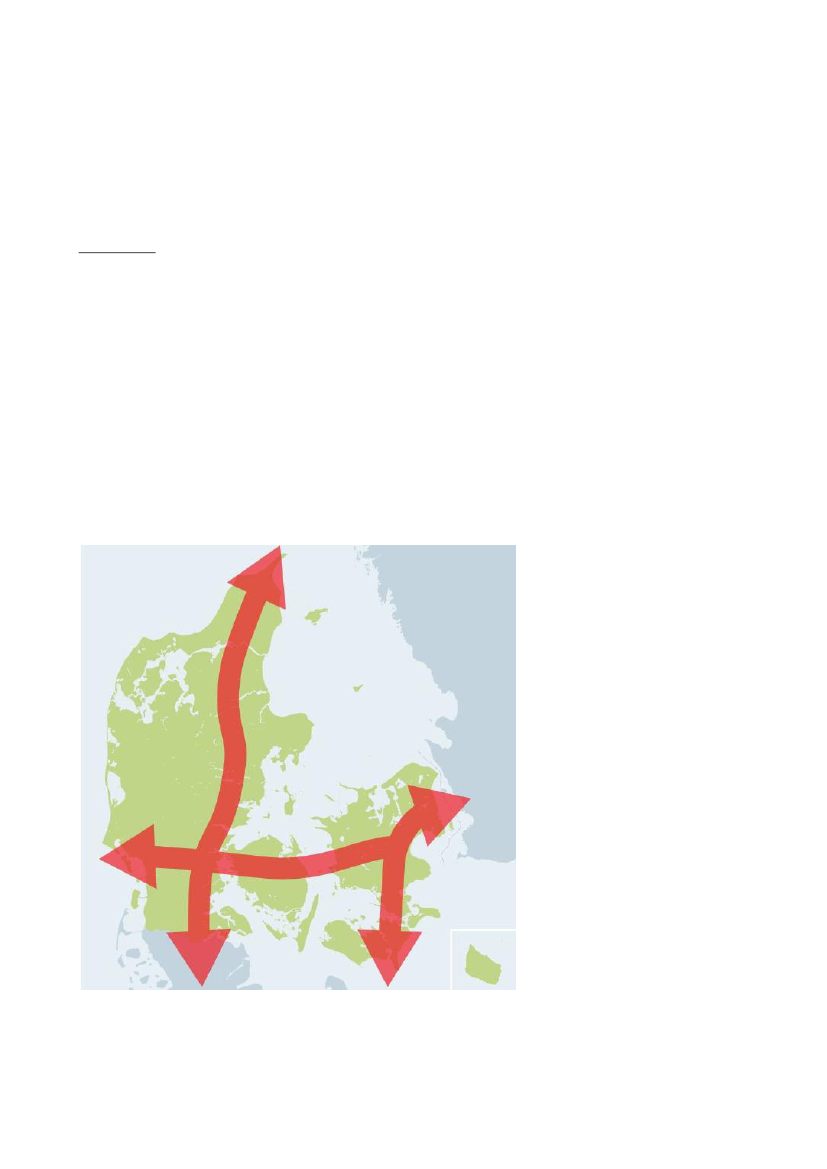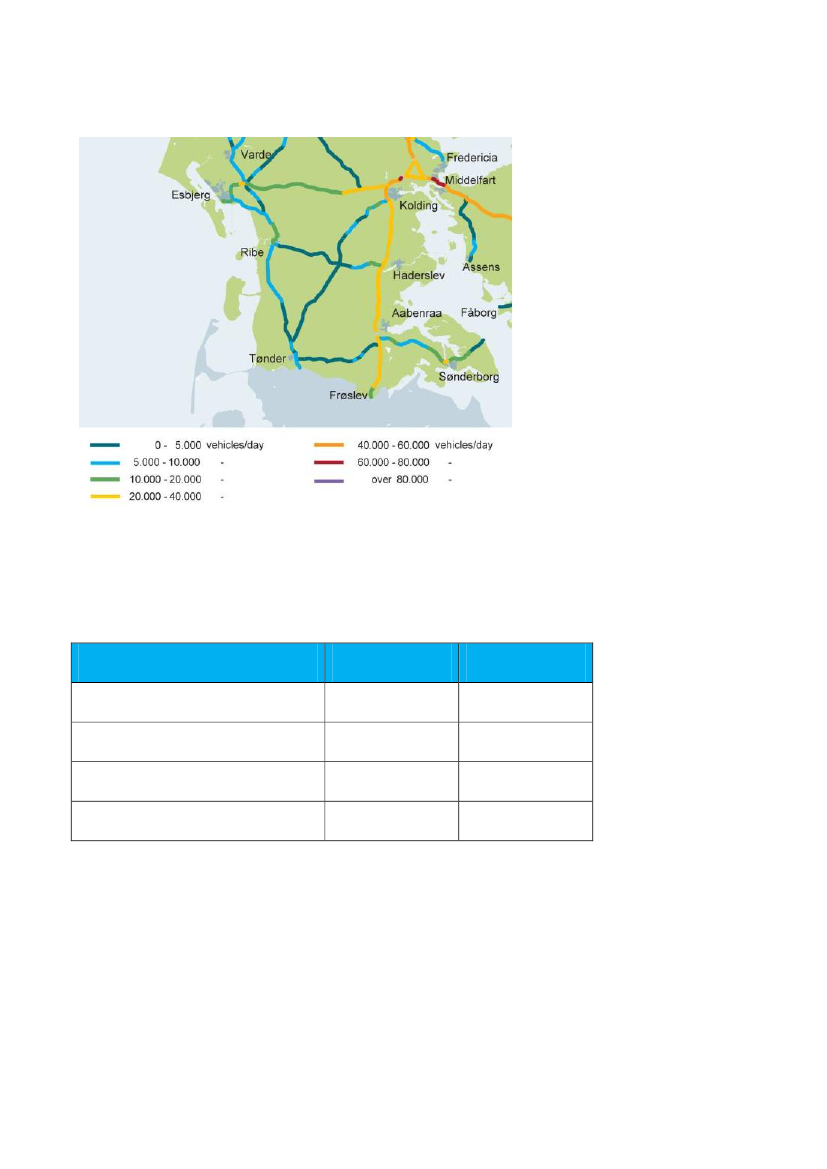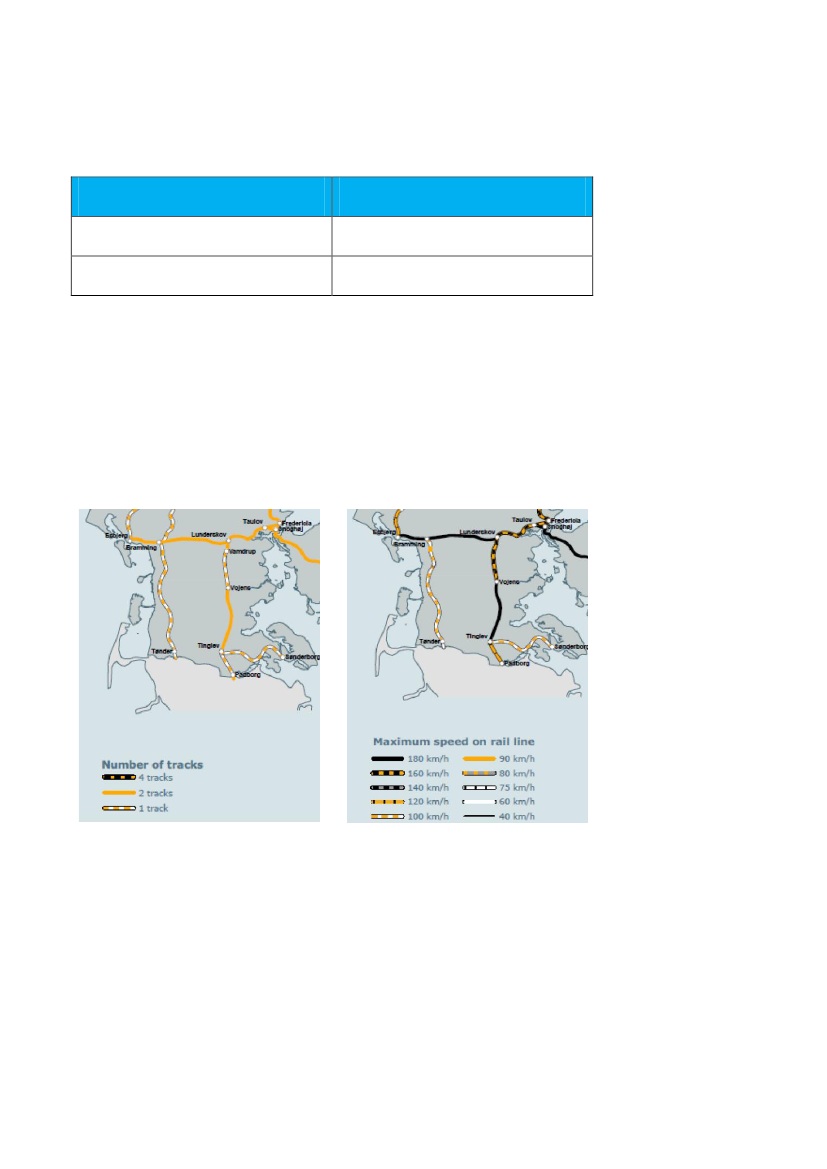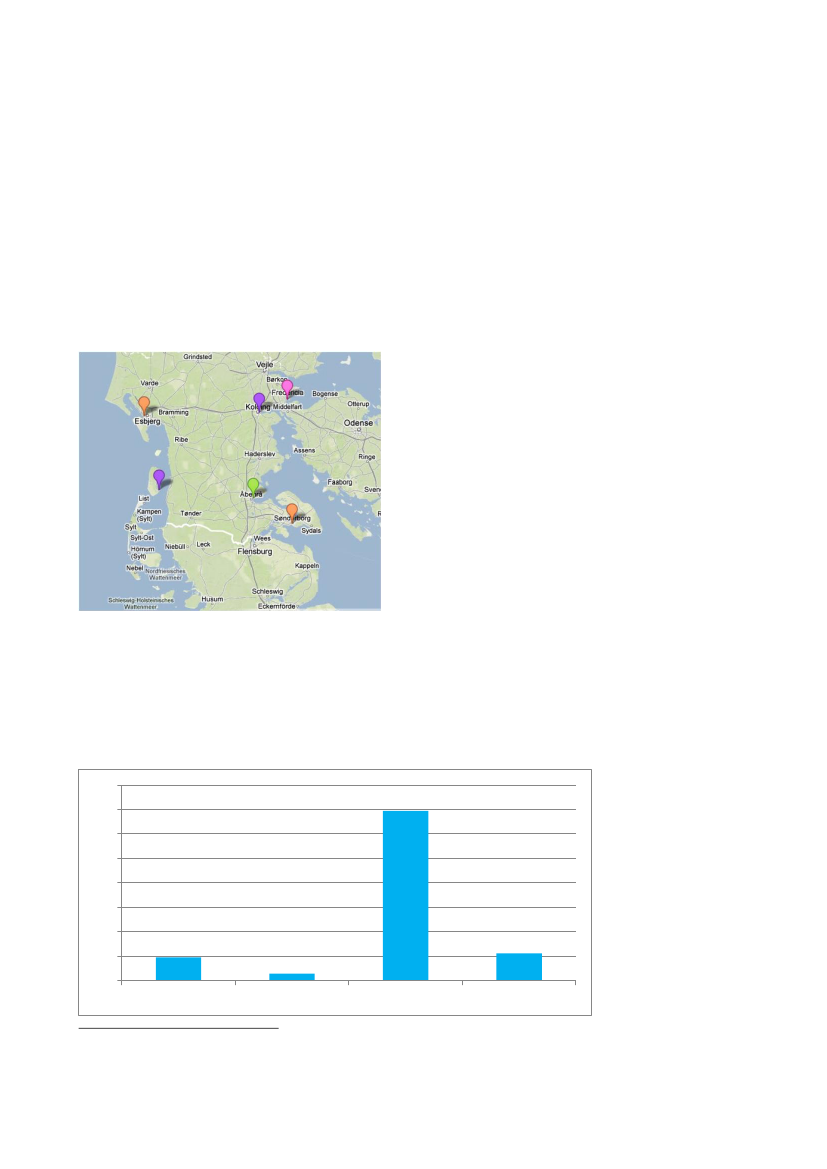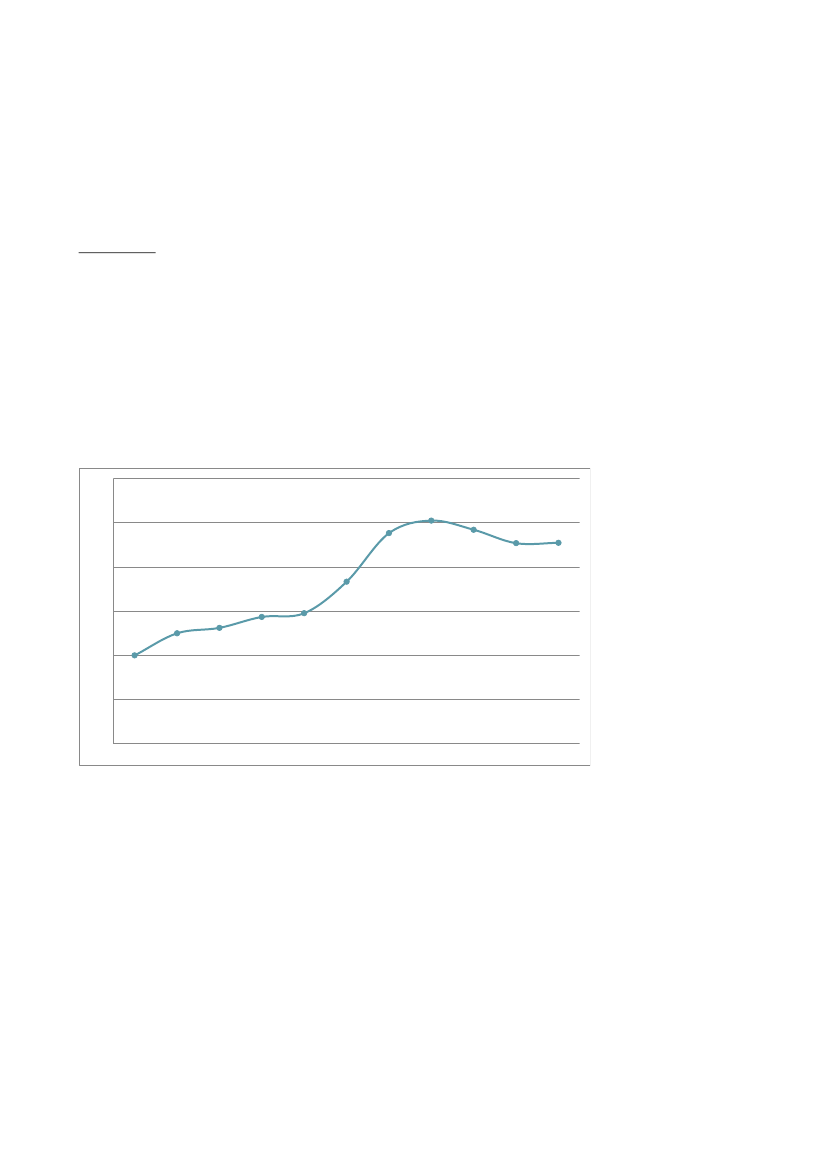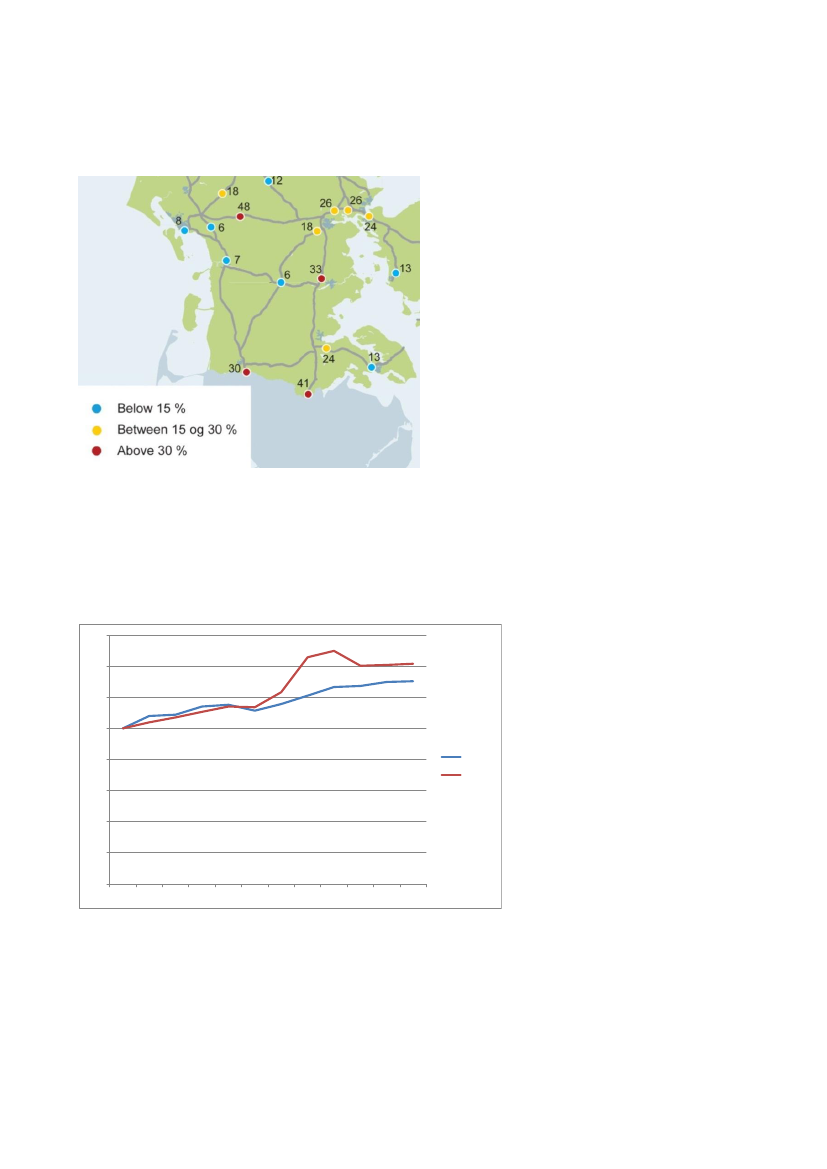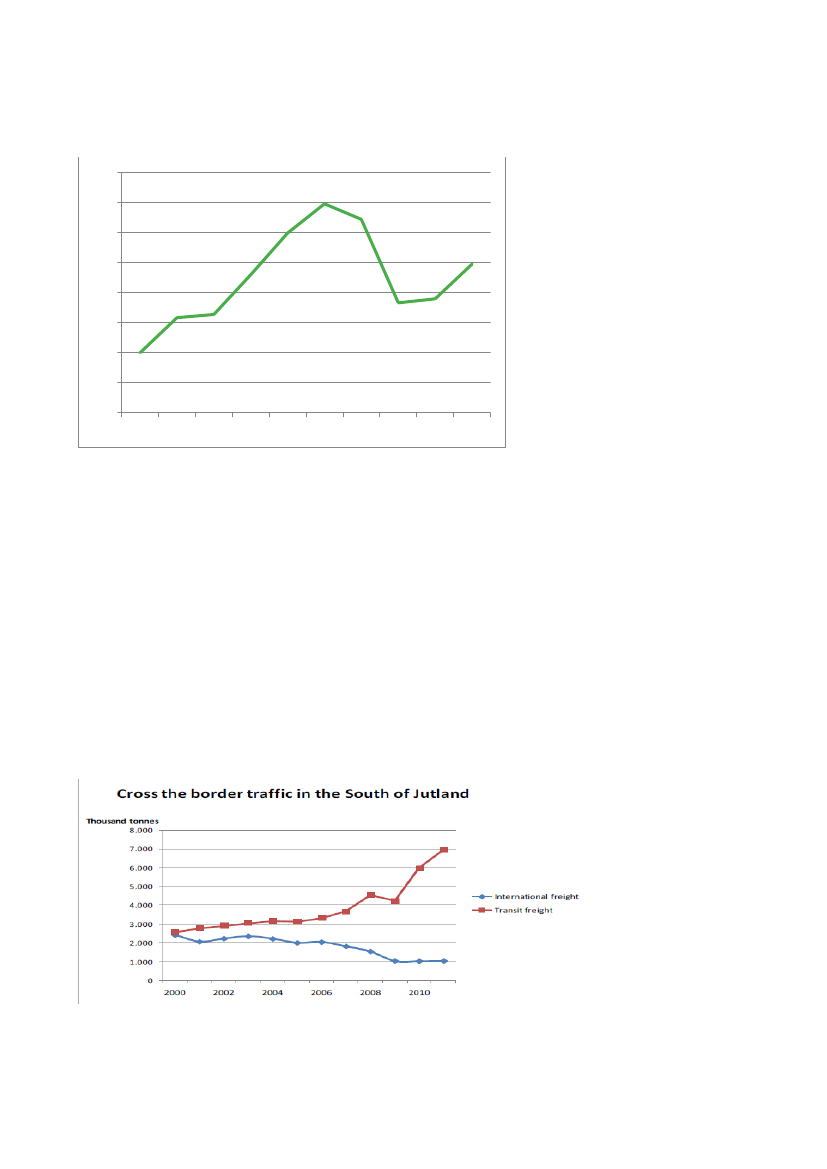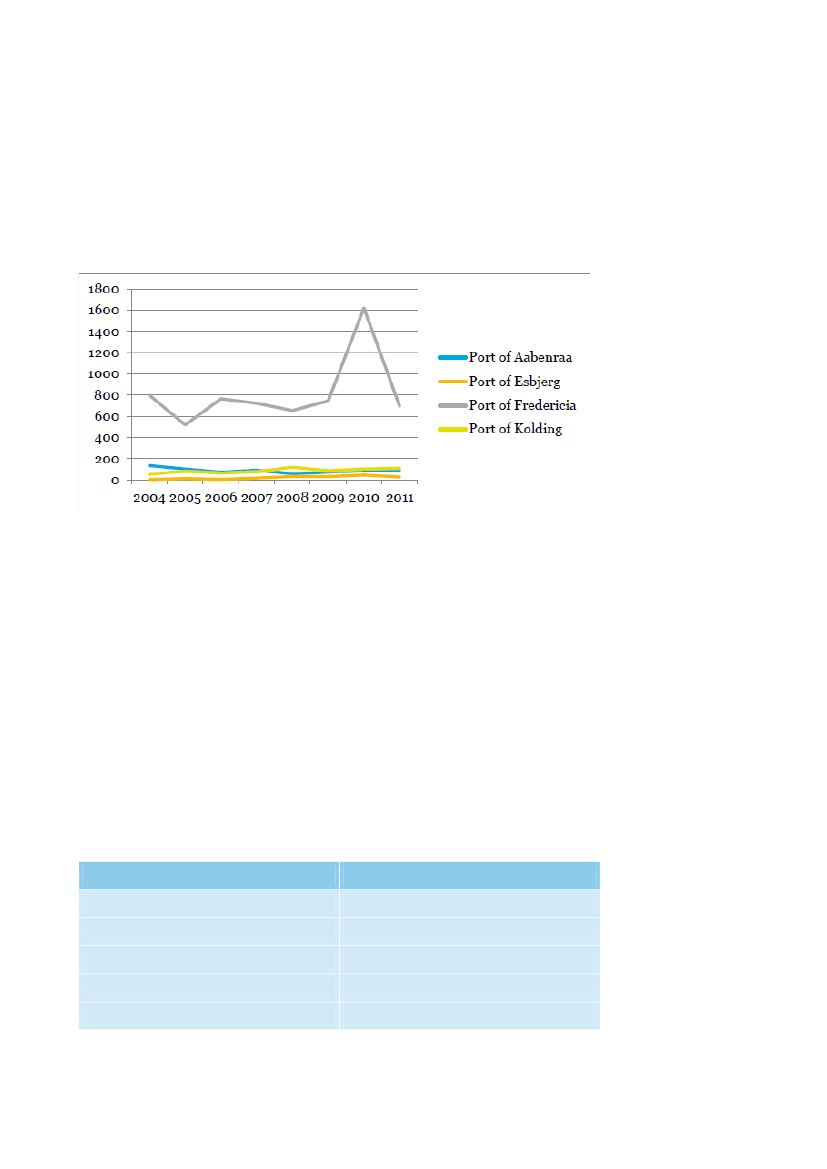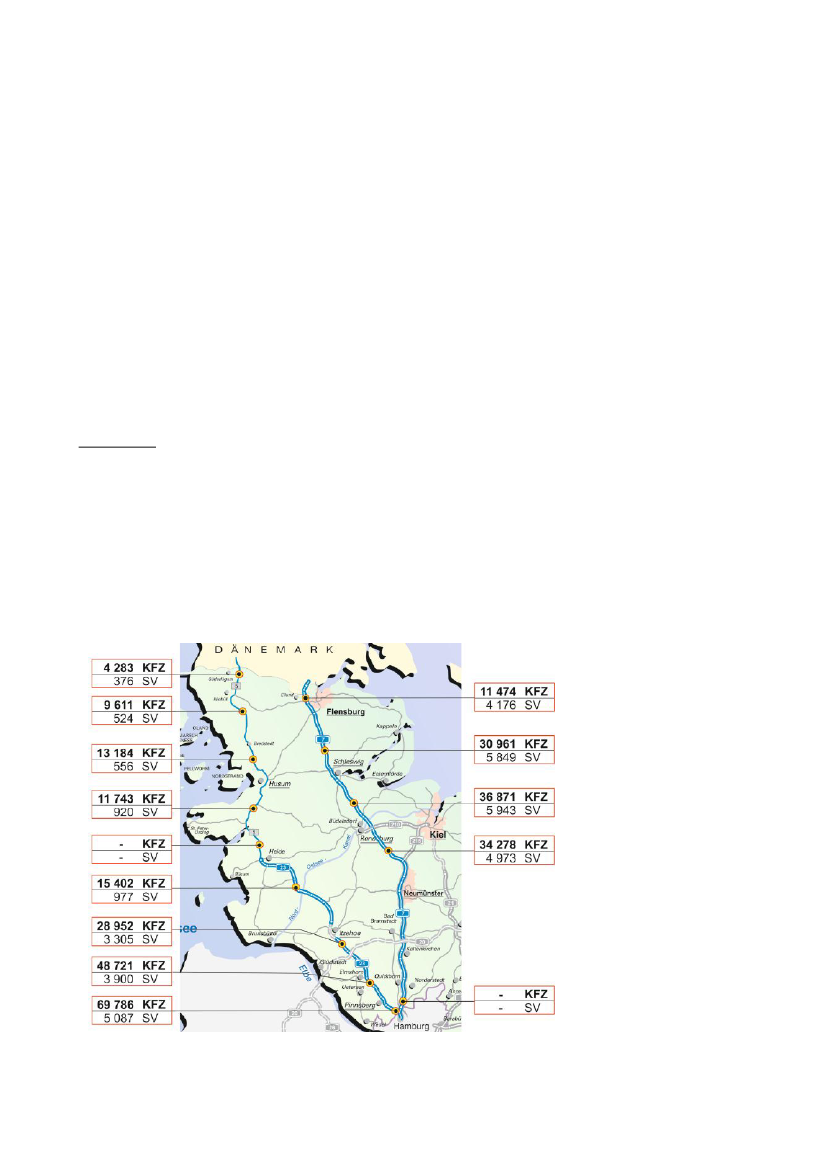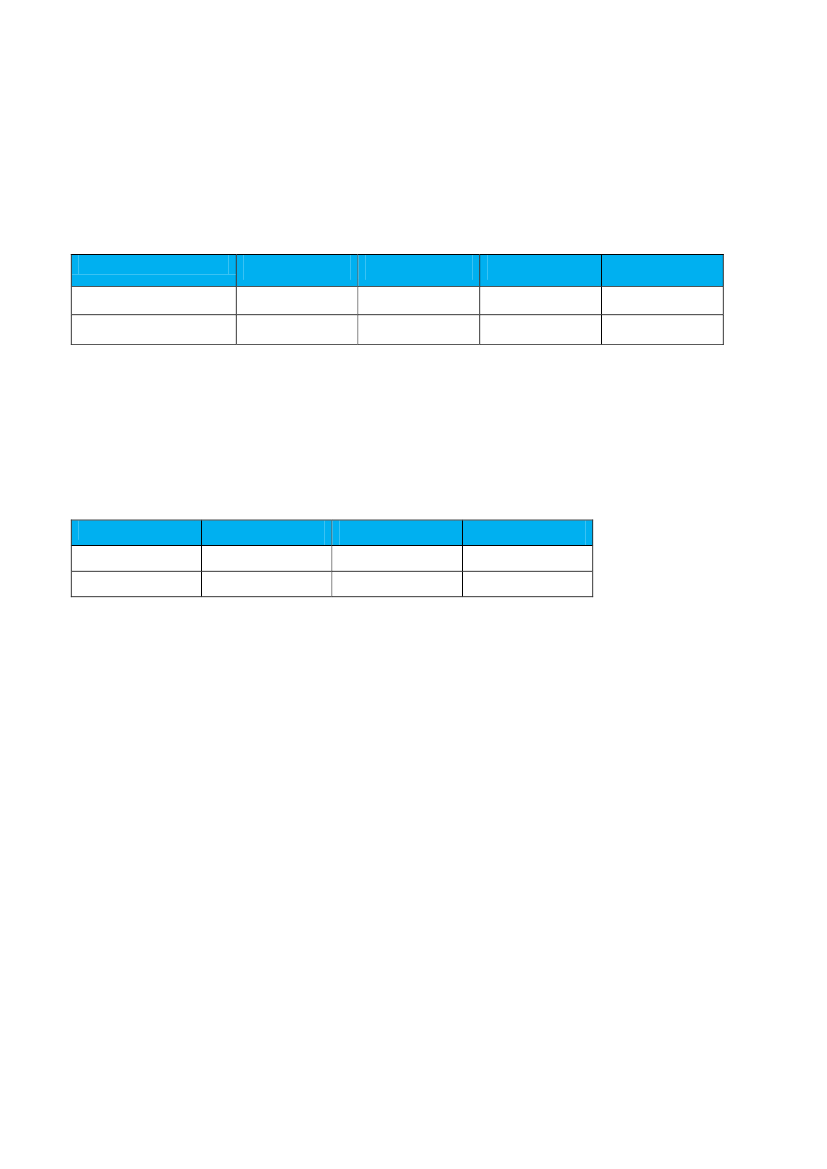Transportudvalget 2012-13
TRU Alm.del
Offentligt
10 December 20122010-2276
Chapter 1. IntroductionDenmark and the Federal Republic of Germany and have a common land border that divides theCimbrian peninsula, which includes Jutland and Schleswig-Holstein, in east-west-direction. In the so-called Jutland Corridor running North-South both states are connected by roads and railway lines.This interim report acknowledges the regional and local effort to improve cross-border mobility thatwas already agreed upon in the partnership declaration between the region of Syddanmark andSchleswig – Holstein signed on 6 July 2007.The project "Cross Border Logistics - CB Log" was carried out from 1 May 2009 to 30 September 2012as an INTERREG project with complementary financial support from Schleswig-Holstein’s “Future ofBusiness Programm” (Zukunftsprogramm Wirtschaft). It was undertaken by the Business DevelopmentCorporation Schleswig-Flensburg (WiReg), the University of Applied Science in Flensburg and theDanish partners UdviklingsRåd Sønderjylland Aabenraa and EUC Syd EUC Sønderborg. This interimreport sets out to provide the Danish-German Transport Commission with a state of play.The Danish-German Transport Commission was set up on 5 August 2011 by the Danish Minister ofTransport, the Federal German Minister of Transport and the Prime Minister of Schleswig-Holstein ofthat time (Hans Chr. Schmidt, Peter Ramsauer and Peter Harry Carstensen respectively).The overall objective for the Commission is – in brief - to create a closer cooperation between Denmarkand Germany regarding transport planning and help achieving a better coordination of infrastructureinvestments. Furthermore, its objective is to analyse cross-border traffic and to develop suggestions forimproving the infrastructure and the transport economy. The terms of reference is annexed to thisinterim report.Since special commissions and task forces are already set up for the Fehmarn Belt fixed link, theDanish-German Transport Commission has its focus on the Jutland corridor. The Commission isconsultative but focuses on all transport issues which are cross-border in nature and thereby affectingtransport and traffic in the neighbouring country, i.e. infrastructure plus all transport modes (road, rail,waterways, harbours and aviation).
[1]
The Danish-German Transport Commission has 12 statutory members and additional experts have beeninvited depending on the demand and agenda. The chair is shared and alternating between Denmarkand Germany.From Denmark the statutory members represents the Danish Ministry of Transport, The Region ofSouthern Denmark, Danish Chamber of Commerce, Confederation of Danish Industry and one memberappointed by the Danish Minister of Transport. From Germany the statutory members represents theSchleswig-Holstein Ministry of Transport, the Federal German Ministry of Transport, HamburgChamber of Commerce, Chamber of Commerce and Industry, Schleswig-Holstein and BusinessDevelopment Corporation, Schleswig-Flensburg.This interim report describes the existing transport infrastructure, the development of the differenttransport carriers since the year 2000 as well as the concrete plans for construction measures andcross-border projects in the Jutland Corridor.Thus, this interim report intends to create the basis for the final report which will include a forecastregarding the development of traffic and give recommendations resulting from the work of theTransport Commission for the transport policy.
[2]
Chapter 2. Description of the cross-border infrastructure and transport structure in theJutland CorridorThis chapter focuses on the cross-border infrastructure and transport structure for Denmark andGermany respectively.Denmark:2.1 Roads:The trunk road network - or the national road network in Denmark - plays a central role when it comesto the flow of traffic. The trunk road network is the backbone of the key international transportcorridors throughout Denmark and helps ensure efficient traffic flow between Scandinavia and the restof the continent.The backbone of the road network is made up of the so-called capital "H", i.e. roads betweenFrederikshavn and Danish-German border, between Køge and Esbjerg and between Elsinore andRødby. See map 2.1.1. The capital “H” provides gateways to Denmark’s neighbours most notablyGermany, Sweden, Norway and the United KingdomMap 2.1.1 The capital “H”
[3]
Despite the fact that the trunk road network only makes up approximately 5 per cent of the total publicroad network in Denmark, approximately 45 per cent of all vehicle kilometres in Denmark are driven onthe trunk road network.The southern part of Jutland is part of the region “Southern Denmark”. In this region there are locatedtwo motorways, which are part of the capital “H”, namely the East-West oriented Esbjergmotorvejen(E20) between Lillebælt and Esbjerg and the North-South Sønderjyske motorway (E45) betweenKolding to the North and the Danish-German border at Frøslev to the South. South of the border toGermany E45 continues as A7.In the western part of Jutland there is one trunk road (Route 11) between Esbjergmotorvejen to theNorth and the Danish-German border south of Tønder and a number of trunk roads across the region.South of the Danish-German border Route 11 continues as B5.A new motorway – Kliplev-Sønderborg – between Sønderjyske motorway to the West and Sønderborgto the East opened in 2011. The 25 km 4 lane motorway was carried out as a Public Private Partnership(PPP). The Kliplev-Sønderborg motorway was the first Danish motorway carried out as PPP.Map 2.1.2 shows the trunk roads in the southern part of Jutland; map 2.1.3 shows the number ofvehicles on the trunk roads in the southern part of Jutland and Table 2.1.1 shows different road types onthe trunk road network in the southern part of Jutland.Map 2.1.2 Trunk roads in the southern part of Jutland
[4]
Map 2.1.3 Number of vehicles on the trunk roads in the southern part of Jutland (2011)
As seen on the map the traffic load is highest on the Sønderjyske motorway (E45) between Kolding andthe Danish-German border at Frøslev.Table 2.1.1 Different road types on the trunk road network in the southern part ofJutlandRoad typeMotorwayExpresswayOther trunk roadsTotalKm Road216114414744Amount (pct.)291556100
Regarding trunk roads there are two border crossings between Denmark and Germany, namely thecrossing at Sæd and the crossing at Frøslev. Table 2.1.2 shows the number of vehicles crossing theborder stations.
[5]
Table 2.1.2 Number of vehicles passing the Danish-German border on a trunk road(2012)Border stationSædFrøslevNumber of vehicles5.80017.200
2.2 Railway:There are two railway lines crossing the Danish-German border: Niebüll-Tønder and Padborg-Fredericia. The railway line between Niebüll and Tønder is single tracked and with a speed limit of 100km/h. Padborg-Fredericia is double-tracked except from Vamdrup to Vojens and from Padborg toTinglev. The speed limit is 180 km/h in some parts of the railway with the lowest speed limit fromPadborg to Tinglev being 120 km/h.Map 2.2.1 with 2011-data from www.bane.dk
The railway between Padborg-Fredericia is part of the North-South TEN-T (Trans-European transportNetwork) railroad network corridor between Aarhus and Hamburg. The section is an important part ofthe Danish railway network, linking West, North and South Denmark with Germany. In the EuropeanCommission, the Corridor Freight Regulation 913/2010 has been commenced with the purpose ofalignment of traffic management, procedures, tools, and documents of freight transport within the EU.The single track section between Vamdrup and Vojens of 20 km. will be upgraded to double track by theend of 2015. This will eliminate the bottleneck problems currently limiting the capacity of the rail lineNorth of Tinglev. The upgrade project received EU TEN-T funding in 2012 to support the development
[6]
of the EU infrastructure. After the upgrade of the section, Tinglev-Padborg will be the last single tracksection left to be upgraded. There is an ambition to eliminate this bottleneck as well in the future.1In 2012 it has been decided to electrify the railway between Esbjerg and Lunderskov. This is the firststep towards electrification of the most important Danish rail lines. The electrification will provide amodern, cheaper, more stable and environment friendly railway.2.3 Ports:Denmark is home to approximately 130 sea ports that function as important nodal points in thetransport chain connecting the Danish economy to neighbouring markets.
In the South Jutland region Danish ports facilitate a wide array of services ranging from frequent feederservices to German ports, short sea shipping of roll-on-roll-off units and transport of oil, gas and drybulk. In recent years ports on the West Coast of Denmark have furthermore carried out investmentprogrammes to facilitate the growth in the wind energy sector and the off-shore wind farms in theWadden Sea and North Sea specifically.Figure 2.3.1: Freight volumes between South Jutland ports and Germany in 2011 (1000 t)8007006005004003002001000Aabenraa Havn1
Esbjerg Havn
Fredericia Havn
Kolding Havn
Ministry of Transport: Aftaler om En grøn transportpolitik, 2009.
[7]
Source: Statistics DenmarkThe most prominent port in the South Jutland region in terms of container freight to/from Germany isthe port of Fredericia. As a feeder port to the Port of Hamburg five weekly connections operate theroute. The prominence of the Port of Fredericia is visualised in fig. 2.3.1 and in 2011 approximately 700tonnes of goods were transported between the Port of Fredericia and German ports.The Port of Esbjerg - the second of the larger ports in the South Jutland region - has a significantlysmaller exchange of goods with German ports.In general the port of Esbjerg handled almost 2,000 tonnes of goods in 2011 and represents a majorconnecting point for Danish foreign trade. Even though the volume of freight between Esbjerg andGerman ports remains marginal, the port of Esbjerg offers an efficient supplement to the Port ofHamburg in terms of short sea shipping access to destinations in the United Kingdom and on theEuropean continent – to the benefit for the border region at large.The ports of Rømø and Esbjerg have taken a proactive approach to accommodate the growing marketfor wind energy. While Esbjerg has focussed on the shipping of wind turbines components from Danishproduction facilities and on supplying services to Danish off shore wind farms, the port of Rømøfocusses on supplying services to German off shore wind farms. Both ports are distinguished by theirability to deliver adequate port depths in the otherwise shallow waters of the Wadden Sea.Finally, a number of small and medium sized ports also contribute to the supply of easy and efficientaccess to waterborne transport in the borderland region. The ports of Kolding and Aabenraa offermodern reception facilities and are important to the region for the supply of building materials,foodstuff and other forms of dry bulk.2.4 AviationCivil aviation in the EU, including domestic routes, is based on an internal market with free access forall carriers in all EU/EEA member states. The companies decide which routes they will serve based ontheir commercial considerations.Domestic scheduled civil aviation in Denmark is concentrated to at present six routes to and fromCopenhagen Airport. Two of the routes serve Southern Jutland: Billund, 130 km from the Germanborder, and Sønderborg, 50 km from the border.In 2011 approximately 140.000 passengers travelled between Copenhagen Airport and Billund Airportand approximately 70.000 passengers travelled between Sønderborg Airport and Copenhagen Airport.There are at present three routes linking Southern Jutland with Germany: between Billund andFrankfurt, Munich and Düsseldorf.The numbers of passengers from Billund and the German destinations are shown in table 2.4.1
[8]
Table 2.4.1. Numbers of passengers from Billund Airport to German destinations.RoutePassengers, 2011Billund – FrankfurtBillund – MünchenBillund –Düsseldorf197.00039.0009.000
Of the larger airports in Southern Jutland, Esbjerg Airport (80 km. from the border) has only routes toAberdeen and Stavanger and Vojens Airport (50 km. from the border) has no routes at all.General aviation is a flexible and important means of transport for most of the regions greatercompanies. From Billund Airport there are flights to a large number of airports - especially in Europe.From both Billund Airport and Sønderborg Airport there are a considerable number of flights toCopenhagen Airport, and from Copenhagen there are a large number of routes to intra- and extra-European destinations. Esbjerg Airport is essential for especially the off-shore industry.Domestic flight routes between Danish and international airports can help to ensure a high level ofregional accessibility and will contribute to regional development, especially for remote areas wheretravel time to Copenhagen is considerably shorter by plane than by train and ferry. Also the airportsbecome essential to the companies in relation to commercial interaction and connectivity and thereby akey element when securing development and economic growth in the regions.
Germany:2.5 RoadsThe most important road connection between the Scandinavian countries and Continental Europe is theA 7 motorway (European road E 45) which leads in North-South direction through all of Germany andup to Frederikshavn in the north of Denmark. In Schleswig-Holstein, the A 7 follows the route of thehistorical “oxen trail”.The Schleswig-Holstein part of the motorway has a length of 146 kilometres and, in accordance withGerman highway standards; it has 4 lanes and a hard shoulder. The hard shoulder between the exitsHamburg-Schnelsen-Nord and Kaltenkirchen and between Neumünster-Süd and the motorwaymerging point Bordesholm can be used if there is much traffic. The A 7 motorway crosses Kiel Canalnear Rendsburg on the Rader Bridge, a viaduct measuring 1.5 kilometres in length.The capital of Kiel is connected to the A 7 by the A 215 motorway at the merging point “Bordesholm”and by the A 210 at the motorway junction Rendsburg. The A 7 is connected with several federalhighways which mainly run in east-west direction and partly in north-south direction. In the city ofHamburg, the A 7 has mostly 6 lanes and 8 lanes in front of the Elbe Tunnel. The motorway mergingpoint “Hamburg-Nordwest” in the city of Hamburg connects the A 7 and the A 23 coming from Heide.As a principal thoroughfare the A 7 takes up large parts of the traffic running in north- south directionwith considerable transit traffic from and to Denmark or Scandinavia. With the completion of the Store
[9]
Bælt Link in 1997, the traffic has partially shifted from the “Vogelfluglinie” (via Puttgarden and Rødby)to the A 7. There is also an increase in commuter traffic mainly in direction to and from Hamburg,meaning that the volume of traffic keeps growing close to Hamburg. The highest volume of traffic isclose to the Elbe Tunnel with 150,000 vehicles per day on the average. Because of the traffic jams thatoccur very often, the Elbe Tunnel is getting to be more of a bottleneck than ever before.The A 7 is especially important for the mobility of the people from Schleswig-Holstein. For manybusiness companies in Schleswig-Holstein it is the most important transport connection to the relevantmarkets, which are often far away. Also for this reason it is especially important that the efficiency of theA 7 be preserved by extension projects which are needs-oriented. Concrete projects plans are describedin Chapter 4.In the West of Schleswig-Holstein the most important transport routes are the B 5 and - from Heide toHamburg - the A 23, which connect the west coast region. The B 5 crosses the German-Danish borderNorth of Süderlügum and as the European road E 11 (Danish Route 11) runs through Esbjerg to theNorth of Jutland to Aalborg. The volume of traffic towards Hamburg is increasing considerably on the B5 and A 23, respectively, as will be shown in the following chapter. The concrete projects are describedin Chapter 4.To create a highly competitive east-west main thoroughfare - from Poland to the Netherlands - the A 20is gradually being built from East to West. The A 20 will be connected with the A 21 motorway near BadSegeberg, with the A 7 near Bad Bramstedt and with the A 23 near Hohenfelde. A fixed link across theriver Elbe is planned near Glücksburg and a connection with the A 26 and the A 27 in Lower Saxony.This project including the fixed link across the river Elbe has been included as an urgent priority in theGerman Federal Transport Infrastructure Plan.With the final extension of the A 20 it will be possible to circuit and decongest the busy traffic hub ofHamburg and to improve the connection to the less developed west coast of Schleswig-Holstein. At thatpoint in time, the A 20 will also be an attractive transport route for the transit traffic running toDenmark.In the coalition contract of the political parties forming the government of Schleswig-Holstein it isagreed that the A 20 will be built in this legislative period to extend it up to the A 7. The segments westof the A 7 including the fixed link across the Elbe will be planned nonetheless. It will be the decision ofthe following government whether these plans can and will be realised.2.6. RailwayIn Schleswig-Holstein the railway network is traditionally orientated towards the railway hub ofHamburg. The main lines are going to Sylt ("marsh railway-line "), Flensburg ("Jutland-line"), Kiel,Lübeck and Fehmarn ("Vogelfluglinie"). The railway network is complemented with cross-countryroutes. In the Jutland Corridor these are the following lines: Flensburg-Kiel, Husum-Jübek-Kiel, Kiel-Lübeck, Heide-Neumünster-Bad Oldesloe and Niebüll-Tønder and - with a more regional character -the lines Niebüll-Dagebüll, Husum- Bad St. Peter Ording and Heide-Büsum.In the Hamburg Metropolitan Region the lines Hamburg-Eidelstedt, Ulzburg-Norderstedt andElmshorn-Henstedt-Ulzburg of the AKN Eisenbahn AG as well as the suburban rail lines (S-Bahnen) to
[10]
Wedel and Aumühle play an important role in commuter traffic. Besides, there are railway lines forcargo transport in Kiel and Brunsbüttel.In the Jutland Corridor the international passenger and cargo transport mainly runs on the line of thesame name. The Jutland-line running to Hamburg via Flensburg, Schleswig, Rendsburg andNeumünster is double-tracked, electrified and constructed for a speed of 160 km/h. Near Rendsburg therailway crosses Kiel Canal on a high-level bridge which was built in 1913. At present, the bridge isundergoing thorough restoration and will be dimensioned for bigger weight charges (load for eachwheel of 22,5 tons). Until completion, which is planned for the year 2014, the bridge is a bottleneckbecause of the speed and weight limitations. Once the bridge has been modernized, it can be crossed by2 trains at the same time and is expected to have an additional operating life of at least 30 years.The Jutland-line and the marsh railway-line converge in Elmshorn. From Elmshorn or rather Pinnebergthe route is complemented with regional railway and suburban traffic. With the introduction of theStore Bælt-Link in 1997 the total cargo transport by rail was shifted to the Jutland-line. This tracksection has nearly reached the end of its capacity. It is expected that the introduction of theFehmarnbelt Fixed Link will partially shift transport activities from the Jutland-line back to theVogelflugline via the Fehmarn Belt Fixed Link.The Federal Transport Infrastructure Plan (“Bundesverkehrswegeplan” - BVWP) contains the three-tracked extension between Elmshorn and Pinneberg in the so-called urgent need (“VordringlichenBedarf”). In autumn 2010, the BMVBS evaluated the planned projects with the result that this extensionis not necessary anymore, because a relief is expected with the completion of the Fehmarn Belt FixedLink.As an alternative to the conventional three-tracked extension the State of Schleswig-Holstein hassuggested an improvement of the suburban connections. This would also free up capacity on the maintrack.In general, the railway hub of Hamburg is a bottleneck, especially for the rail traffic running in southerndirection.The problem was examined by the BMVBS (especially in a report about the “Development andassessment of a concept for the railway hub Hamburg of March 2009”). The report recommends thatthe railway connections to the South for container-transport and for the suburban rail lines beextended.The description of the special problems associated with the railway hub Hamburg would exceed thisinterim report.The marsh railway-line leading from Hamburg to Sylt is mainly double-tracked except for a few one-tracked sections and designed for a speed of 140 km/h. The marsh railway-line is electrified fromHamburg to Itzehoe. In Niebüll it is connected via Tønder and Esbjerg with the Danish railroad networkby the privately owned company Norddeutsche Eisenbahngesellschaft Niebüll GmbH (neg). The 17.7 kmlong single-tracked and non-electrified section between Niebüll and Tønder that had been closed downin 1980 was reactivated in 1997. A few years ago, the track was redeveloped with financial support fromthe State of Schleswig-Holstein.
[11]
2.7. ShippingThere are two regular ferry services between Germany and Denmark. On the one hand there is the so-called “Vogelfluglinie” between the ports of Puttgarden and Rødby, on the other, there is a ferry-connection between the ports of List on the island of Sylt and Havneby on the island of Rømø. Becausethis interim report is about the Jutland Corridor, only the line between List and Havneby will bedescribed.For individual traffic from the mainland this 16-km-long ferry connection is a popular alternative to therailway connection via the Hindenburgdamm. The ferry service is operated by Syltfahre.de, anenterprise of the FRS (Förde Reederei Seetouristik), using a double-ended ferry called SyltExpress. Thecrossing takes approx. 35 - 40 minutes. The ferry service has been operating since 1963 and is used byapprox. 400,000 passengers yearly. The cargo transhipment amounted to about 92,600 tonnes in 2011.This interim report does not describe the Kiel Canal (NOK). As an international waterway the NOK isvery important for the transport of cargo into the whole Baltic Sea area, largely from and to the Port ofHamburg, but it does not have a special function for the cross-border transport of goods in the JutlandCorridor.2.8. Air trafficThe airfield Flensburg-Schäferhaus is the only airfield with a crossborder function in the Schleswig-Holstein part of the Jutland Corridor. Because of its location near the border it is also used by Danishcustomers. The airfield was already founded in 1910. It has three runways. One runway is made ofbitumen has a length of 1,580 m and a weight-bearing of maximum 30 t. Therefore, the airfield is wellsuited for business charter flights.Close to the airfield there are charter enterprises which offer commercial and private flights as well assightseeing flights. Furthermore, Germany’s largest seaplane enterprise has its seat in Flensburg. Flightschools offer lessons for flying airplanes, gliders, ultralight planes and seaplanes as well as forparachuting. Aerial advertisement and hangar places are offered.Besides, an aviation-technical company (servicing and repair of motorized aircraft) is located on theairfield as well. The fuelling facilities offer AVGAS 100 LL for piston engines as well as jet A 1 (kerosene)for turboprop aircraft and jet engines. The water aerodrome Flensburg-Sonwik in the Flensburg fjord isclose by.Beyond the borders of Schleswig - Holstein the airport of Hamburg-Fuhlsbüttel (Hamburg Airport) isalso interesting for Danish travellers. It offers a huge number of German and European destinations aswell as some intercontinental connections.
[12]
Chapter 3. Development in traffic in the Jutland-corridor from 2000 to today. Figuresand facts.This chapter has its focus on the development in traffic in the Jutland-corridor from approximately2000 to today. The chapter describes the development in Denmark and Germany respectively.Denmark:3.1 Roads:Developments in traffic concerning roads can be analyzed by using several parameters. For examplewith traffic performance calculated by the mileage of the various means of transport travels during aperiod. The traffic performance thereby expresses to what extent the load of traffic affects theinfrastructure. Figure 3.1.1 shows the trend in traffic performance (driven km) in southern Jutland. Asseen on the figure the traffic has been increased with 15 percent 2001 – 2011.Figure 3.1.1 Trends in traffic performance in the southern Jutland 2001 – 2011(2001=index 100)120
115
110
105
100
95
9020012002200320042005200620072008200920102011
There is a fall in traffic growth in 2007 due to the financial crisis.
Map 3.1.1 indicates traffic trends based on traffic counting 2000 – 2010 at selected locations on thetrunk roads in the southern part of Jutland.
[13]
Map 3.1.1 Increase in traffic (in percentage) at selected sites in the southern part ofJutland, 2000 – 2010.
There has been an increase in the number of vehicles passing the two border trunk roads betweenDenmark and Germany. Figure 3.1.2 shows the trend in the number of vehicles crossing the border andFigure 3.1.3 shows the development in truck traffic across the Danish-German border (northbound)from 2002 – 2011.Figure 3.1.2 Trends in the number of vehicles passing the Danish-German border inJutland 2000 - 2011 (2000 = index 100).160140120
1008060402002000 2001 2002 2003 2004 2005 2006 2007 2008 2009 2010 2011Sæd
Frøslev
[14]
Figure 3.1.3. Development in truck traffic across the Danish-German border(northbound) 2002 - 2011 (Index 100 = 2002)13012512011511010510095902002 2003 2004 2005 2006 2007 2008 2009 2010 2011Source: International Transport Danmark andestimates made byVejdirektoratet
Overall the growth in traffic in southern Jutland is similar to the growth in the rest of Denmark.3.2 Railway:Freight transportationThere is an ambition to improve rail road freight transportation in Southern Jutland and across theborder. A freight terminal will be established in Esbjerg together with a rail line to the Port of Esbjerglinking railroad freight to sea transport. Recently Vestas has chosen the railway as the preferred way oftransport of wind mill wings from Lauchhammer in Germany to the Port of Esbjerg.The chart below illustrates the development in freight transport (tonnes of cargo) in the period 2000-2011. The railroad freight transit has increased by 270 per cent. The railway freight transportation inand out of Denmark (measured in tonnes) has declined by 57 per cent in the same period.Figure 3.2.1. Development in freight transport from 2000-2011
Data is from Statistics Denmark. The fraction crossing the border in Southern Jutland is calculated from DanishTransport Authority.
[15]
With regard to transit trains, there has been a significant larger increase in transported cargo (tonnes)compared to the increase in number of trains since 2006, which means that trains have become longerin recent years. Between 2006 and 2011 the number of transit trains has increased by 68 per cent whilethe number of international trains has declined by 39 per cent.It is estimated that the railway freight transit traffic will increase by 2.4 per cent per year until 2020 andhereafter 3 per cent year until 2027. This will result in 16.2 milli0n tonnes per year in 2030. One fifth ofthe 16.2 million tonnes are expected to be transported through Jutland to Germany2.Passenger transportationThe intercity trains operation every two hours between Copenhagen and Flensburg are the backbone ofthe railway traffic via Padborg. The trains – operated by DSB – have a German train control system. InFlensburg there are good connections to high speed regional trains to Hamburg, which are to beextended from two-hour traffic to one-hour traffic. In addition two international trains will beestablished; Århus-Hamburg (-Berlin) and a night train Copenhagen-Amsterdam/Praha/Basel. Out ofthe 400.000 train passengers travelling across the Padborg border each year, approximately 80 per centtravel to and from Jutland and 20 per cent to and from Funen and Zealand.On the Tønder-Niebüll rail line, regional trains cross the border every two hours. In Niebüll there aregood connections to high speed regional trains to Hamburg. The number of passengers crossing theborder by train via Tønder is 80.000 per year that support operation of regional trains3.The map beneath depicts annual passenger trips in 1995 and 2010 and shows an increase in number ofpassengers crossing the border via Padborg. It is not possible to draw conclusions on passengerdevelopment on the rail line crossing the border via Tønder due to the lack of data from 1995.
23
Danish Transport Authority: Den fremtidige omsætning af gods på bane i DanmarkDanish Transport Authority: Hearing edition of the national traffic plan.
[16]
Map 3.2.1. Annual passenger trips in 1995 and 2010
3.3 Ports:Traffic volumes in South Jutland ports can roughly be divided into two categories; freight and passengertransport.FreightIn general, Danish ports also felt the consequences of the global economic downturn. Activity in portsand the amount of freight volumes handled entered into a downward trend in the years 2008-2010.After three consecutive years of reduced activity, the pattern appeared to be changing in 2011 as freightvolumes grew, albeit cautiously (fig. 3.3.1).
Fig. 3.3.1: Development in freight volumes in Danish ports (1000 t)
Source: Statistics Denmark
[17]
In terms of the transport of goods between South Jutland ports and Germany, the impact of theeconomic downturn is less apparent. Although 2008 did coincide with a slight downwards trend ingoods volumes, the development in the subsequent years appears to be less of a result of the generaleconomic climate. According to fig. 3.3.2 the transport of goods between South Jutland ports andGermany are more or less on par with the situation before the global economic downturn.Fig. 3.3.2: Development in freight volumes between South Jutland ports and Germany(1000 t)
Source: Statistics Denmark
Passenger transportThe ferry service from the port of Esbjerg to the island of Fanø is the busiest domestic service inDenmark. In 2011 the ferry service handled almost 1.7 million passengers and more than 300.000private cars.South Jutland is also home to a second domestic ferry link between the island of Als (Fynshav) andFunen (Bøjden). The Fynshav-Bøjden link represents an important alternative to the fixed link acrossthe Little Belt and provides a shortcut to Funen for the border region.In addition to the domestic South Jutland ferry lines, an international route operates between the islandof Rømø (Havneby) and Sylt (List). The 2011 traffic volumes of the Rømø-Sylt link are listed in table3.3.1. A sizeable passenger transport and the substantial accommodation of bicycles are indicative of theimportance of the ferry link to local communities and not least with regard to tourism.Table 3.3.1: Transport volumes, Rømø-Sylt2011PassengersCarsBusseLorriesBicyclesSource: Statistics Denmark
293.00053.4001.2008.3006.500
[18]
3.4 Air traffic – The case of Sønderborg AirportSønderborg Airport is owned by Sønderborg Kommune (municipality). The airport was historically tiedto the Danish airline Cimber (later Cimber Sterling) which had its head office at the airport and for 46years served the route to and from Copenhagen until its bankruptcy in May 2012.The route was immediately taken over by the Danish carrier DAT. In 2011 the airport had about 80.000passengers whereof about 70.000 used the only scheduled route to and from Copenhagen.As part of its development plans, in 2010 the airport engaged a consultancy firm to report on thepossibilities for changing the airport into a “binational” Danish/German airport, or for other co-operative arrangements, with the main purpose of attracting more passengers from the German side ofthe border to the existing route to Copenhagen and to new routes that might be created. Within 1 ½driving hour from the airport live 1.6 million people, whereof 40 per cent in Germany. The analysis hasreceived support from the EU’s European Regional Development Fund.Germany:3.5. Development in road trafficThe development of traffic volume in the Jutland Corridor is shown in the following representations.The maps, which are based on Germany-wide traffic counts, present the average traffic per day(Monday to Sunday) expressed in number of vehicles per day. These counts distinguished between:- KFZ = all types of motor vehicles and- SV = heavy vehicle traffic (more than 12 tons of weight and busses).Traffic counts in the year 2000
[19]
Traffic counts in the year 2005
Traffic counts in the year 2010
[20]
For the A7 it can be concluded that the volume of traffic has risen between the years 2000 and 2010.Especially in the area close to the border the increase is higher than the average. The further south themore moderate was the rise in traffic volume. But still, this trend is no indication of the efficiency of thisparticular road section given that the absolute congestion rate is higher than in the north.This entails that the capacity of the A7 north of the interchange A7 / A215 can be considered to besatisfactory. Merely single road sections are critical, as for example the area of the Rader Hochbrücke,the high-level bridge near Rendsburg at certain times. South of the above-mentioned motorwayinterchange, traffic capacity is regularly overstretched, especially in the area around Neumünster and inthe metropolitan area of Hamburg.There is a similar development concerning the motorway A 23 and the B 5, respectively: over-proportional increases can be observed in the area close to the border; whereas towards the south theincreases of traffic are more moderate. Problems on the B 5 are mainly caused by tourist andagricultural traffic in the summer months, especially in the section between Tönning and Bredstedt.South of Heide the quantity of traffic reaches a volume that warrants the profile of a motorway.Concerning heavy vehicle traffic it can be concluded that the increase in Schleswig-Holstein is onlymoderate. In the area close to the border there are also over-proportional increases.3.6. Development in rail trafficCurrently, there are two border crossings between Schleswig-Holstein and Denmark which are used bythe local passenger traffic (SPNV), namely Flensburg - Padborg and Niebüll - Tønder. Via the trainstations on the Danish border there are through trains from Flensburg to Kolding, Odense, Roskildeand Copenhagen as well as from Niebüll to Esbjerg.The border crossing at Flensburg - Padborg is used by the SPNV as well as by international long-distance passenger traffic and cargo traffic. While the state is responsible for the SPNV as a so-called“Aufgabenträger”, i.e. operator, it does not have any influence on the long-distance traffic, because thisis carried out by Deutsche Bahn AG (DB AG) and the Danish state rail (DSB) serving their own financialinterests.In long-distance traffic 2 pairs of trains (Hamburg-Arhus and Berlin-Arhus) are offered by DB AG undDSB. In addition, there is a night-train from Copenhagen to Basel, Amsterdam and Prague. For the“SPNV” the state Schleswig-Holstein has ordered 9 pairs of trains offering a connection every twohours. The trains are mostly from Flensburg directly to Copenhagen and are driven with a Danish IC3motor train set. These trains have a standard that is appropriate for long-distance travel and they partlyserve as a substitute in this function. The number of passengers travelling daily could be increased sincethe takeover of the operation by the DSB in 2011 from nearly 250 passengers per day to more than 400passengers per day.The border-crossing Niebüll - Tønder was put into operation during the last years for the “SPNV” againwith the supply of transport being extended step by step. Currently, there are 10 pairs of trains crossingthe border on workdays and 7 on weekends. The service is provided by the railway company of Arriva, aforeign daughter company of the DB AG. The service is mainly used by German pupils who are going tothe Danish high school in Tønder. The number of passengers using this line is steadily rising and in
[21]
particular in summer there is a big demand by tourists. Since 2006, the demand could be increasedsubstantially. As a model of good cross-border cooperation the Danish Transport Authority is in chargeof this section.The following table shows the development of the average everyday passenger-transport in cross-borderpassenger traffic, i.e. SPNV:Railway lineTønder - SüderlügumPadborg - Flensburg20035726720069825220101312622011112420
Altogether, the cross-border railway-traffic starting from a low level is developing very successfully. Inorder to support this trend, there are plans to extend both connections to run every hour in themedium- to long-term.3.7. Development in shippingThe ferry services between List/Sylt and Havneby/Rømø has developed as follows:2000TransshipmentPassengers53.654 t415.467201059.994 t421.072201192.634 t*389.563
*Increase in quantity because of some bigger building projects on the island of Sylt3.8. Development of freight trafficIn the area of the A 7/border crossing Ellund the average everyday quantity of traffic (dtV) has risenfrom approximately 12,400 vehicles in 2005 to 16,200 in 2010. The share of trucks is approximately 25per cent. In the area of the B 5/federal border to Denmark the dtV has raised from 4,283 motor vehiclesin 2000 to 5,771 vehicles in 2010. The share of trucks is approximately 4 per cent (Source: Traffic countin 2010).In 2008 the cross-border volume of freight traffic in the German-Danish border region amounted to23.7 million tons by truck and 6.2 million tons by rail (Source: CB Log).3.9 Development of air trafficIn the year 2000, there were about 16,600 flight movements counted on the airfield Flensburg-Schäferhaus (takeoffs and landings by airplanes). In 2005 this number amounted to 13,200 and in 2011to 12,900.At the airport of Hamburg-Fuhlsbüttel about 165,000 flight movements and some 10 million passengerswere counted in 2000. In 2005, the number of flight movements had dropped to about 156,000 (with10.7 million passengers) and in 2011, there were 158,000 aircraft movements (with 13.5 million
[22]
passengers). Nearly 40 per cent of the flights are for business purposes and 55 per cent for privatereasons.In the years 2010 and 2011 the airport of Hamburg registered about 80,000 to 100,000 Danishpassengers (journey from Denmark and flight from / to Hamburg, without transfer via Copenhagen).The share of Danish passengers in both years is less than 1 per cent.
[23]
Chapter 4. Current infrastructure programmes in Denmark and Germany -Focusing onthe Jutland corridor.Denmark:In 2009, seven out of eight parties in the Danish Parliament agreed on a number of general principlesand concrete initiatives as part of a new green transport policy that applies until 2020. The rollinginvestment programme allows the political parties behind the agreement to meet regularly and check onthe progress of on-going projects, decide new projects and set new priorities. The concept insures thatinfrastructure projects will be coordinated and prioritised in accordance with the resources available.As a part of the political agreement from 2009 it has been decided to initiate a long-term planning effortto analyse further large-scale infrastructure demands in the years after 2020 and identify majorstrategic options for further infrastructure investments beyond 2020.The strategic analyses focus on three central themes that have a vital impact on the long-terminfrastructure planning in Denmark. The three themes are: 1) road system in Jutland, 2) the east-westconnections between Jutland, Funen and Zealand, and 3) the ring roads and public transportation inthe Greater Copenhagen area. As a part of the analyses a number of specific major roads and railprojects will be considered.Concerning the road system in Jutland it is clear that the motorway E45 in Eastern Jutland hasproduced a high level of mobility and economic development in Jutland, as the road connects Jutlandfrom north to south.Today the overall motorway system serves several types of traffic – which are all growing in volume.This goes for commuter traffic, traffic within and between regions and international traffic flow towardsGermany and Europe.In the long term the traffic growth, however, will engender a need for additional capacity on the E45from Northern Jutland to the German border. As part of the strategic analyses, two main developmentstrategies for north/southbound road capacity in Jutland have been identified:Further development of the motorway capacity in the E45 corridorDifferent models for establishment of a new motorway corridor in Central Jutland.
The strategic analyses are due to be fully completed in late 2013 after which the parties will discuss theresults as part of the continuous planning in the transport sector.In recent years there has also been invested heavily in upgrading the existing rail infrastructure inDenmark. The political accord states that the train must be a viable alternative to the car, and most ofthe traffic growth in the future must be absorbed by public transport.Investments have also been made in the European Rail Traffic Management System (ERTMS) that willharmonize the European signal systems and make all Danish rail transport more efficient. Installationwill start on early deployment lines in 2017 and 2018 for total testing in commercial service before themain roll-out of the new signalling system. The main roll-out is planned for a period of four years from
[24]
2018 through 2021 with an overlap between lines, prioritised according to the traffic level, with roll-outtaking place fist on the most heavily used lines.Cf. paragraph 2.2 it has been decided to upgrade the single track section between Vamdrup and Vojensof 20 km. to double tracks. The upgrade will be finalised ultimo 2015 and will eliminate the bottleneckproblems currently limiting the capacity of the rail line North of Tinglev. It has also been decided toelectrify the railway between Esbjerg and Lunderskov. This is the first step towards electrification of themost important Danish rail lines. The electrification will provide a modern, cheaper, more stable andenvironment friendly railway.Furthermore investments will be made in a program focussing on repairing and replacing rail tracksand bridges in order to improve the reliability.Finally ports play a key role in terms of Danish international trade. The main share in terms of volumeof all imports and exports is transported by ship. This makes ports a central node for freight transportalso providing intermodal transport.Germany:In Germany the federal transport routes are basically planned and financed by the federal state (Bund).The main strategic planning instrument covering all transport carriers is the Federal TransportInfrastructure Plan (BVWP). The projects are categorised in an “urgent priority” (VordringlicherBedarf) and in an “additional need” (Weiterer Bedarf). However, the BVWP is not a finance plan. Thismeans that even the projects anchored in the urgent need do not get their financing "automatically".The existing BVWP from 2003 is underfinanced because of the open gap between the need and theactual finance situation of the federal transport budget since years.The BVWP is decided by the Federal Government and can be characterized as merely being arecommendation. However, the plan was taken up by German Parliament (Bundestag) for the federalrailways and the federal major roads in the so-called "needs plan" (Bedarfsplan), which is an annex toboth the Federal Railway Extension Act (Bundesschienenwegeausbaugesetz - BSchwAG) and theFederal Trunk Road Extension Act (Fernstraßenausbaugesetz - FStrAbG). These two laws provide that5-year plans be drawn up for the concrete realisation of the needs plan. For this purpose the BMVBScompiles so-called “investment framework plans” (Investitionsrahmenplan - IRP) for a period of 5years. The current IRP is valid for the period 2011 - 2015.At present the Federal Ministry of Transport, Building and Urban Development (BMVBS) is working onthe update of the BVWP which shall be applicable from 2015 and is based especially on a traffic forecastthat will be updated for the forecast period up to the year 2030.State roads (Landesstraßen) are basically financed by the state budget and municipal roads and lanes bythe municipalities and counties. For municipal building projects the federal state and the state ofSchleswig-Holstein give subsidies under certain conditions according to the German CommunityTransport Financing Act (Gemeindeverkehrsfinanzierungsgesetz (GVFG).In the following the most important extension projects are shown.
[25]
RoadsBecause of the growing traffic volume the A 7 will be developed between the motorway junctionBordesholm and the Elbtunnel in Hamburg from four to six or eight lanes, respectively.In Schleswig-Holstein the extension is planned on a length of 65 kilometres. The project costs about290 million €. It is included in the “urgent need” category (Vordringlicher Bedarf) in the BVWP as wellas in the IRP 2011-2015. It will be executed in a public-private partnership as a so-called availabilitymodel (Verfügbarkeitsmodell), meaning that besides the extension, the private company also takes overthe maintenance and the operation service over a period of 30 years. For this a monthly remuneration ispaid. Furthermore, bonus-penalty regulations are planned. The project also contains a basic renewal ofthe existing lanes. To avoid delays as far as possible, 2 lanes per direction can be used by the trafficduring the construction period. Therefore, the extension work will be only on one side, while the trafficruns on the other side.The plan approval decisions of the Schleswig-Holstein sections will be given by the beginning of 2013.The invitation for tenders for the concession for the ÖPP-model is carried out in parallel. The start ofconstruction work is planned for 2014 and the completion for 2018.In the city of Hamburg 3 sections are planned for the extension to 6 or 8 lanes, partly with coverings.The start of the construction work in Hamburg-Schnelsen is planned for 2014; the last section inHamburg-Othmarschen will be finished in 2025.To provide relief for the Hamburg Elbtunnel along the A 7, a northwest bypass of Hamburg including anew link across the river Elbe will be realised with the A 20 in different sections. The A 20 - comingfrom Mecklenburg-Vorpommern - is already used by traffic to the east of Bad Segeberg. The planapproval decision for the following sections between Weede and Wittenborn (south of Bad Segebergwith the connection to the A 21) has to be decided by the courts so that the realization is in delay. Theplan approval decisions for the remaining sections are planned for 2013/14. The A 20 with all sections -albeit in different realization categories – is part of the IRP 2011-2015.There a several extension projects planned for the A 23 and B 5. The new bridge across the river Störwas finished in June 2010. The demolition work of the old bridge has been carried out since October2011. The extension between Itzehoe-South and Itzehoe-North (a four lane-extension of the B 5 to the A23) has been started. The completion of the entire segment including a newly built second bridge acrossthe river Stör is planned for 2015.In the area of the B 5 between Tönning and Husum the planning of a three-lane-traffic managementsystem has begun. The objective is to raise road safety and to be able to manage additional seasonaltraffic. At present, the detailed construction plans are being drawn up, with the beginning of the planapproval procedure being prepared for the first section. The following three sections will be carried outin such a way that a continuous and acceptable construction progress is possible. The project is financedoutside the IRP.To strengthen the competitiveness of the west coast area, the BVWP-project “B 5 bypass Hattstedt –Bredstedt” will additionally be realised. The plan approval procedure was decided on 30 March 2012,but is pending at court. The result of the legal proceedings needs to be awaited. The project is containedin the IRP.
[26]
The state government is of the opinion that the current and the medium-term expected traffic volumeon the B 5 north of Heide to the Danish border does not warrant an extension similar to a four-lanemotorway like it is demanded by the region.RailwayThe following extension projects are planned for the Jutland line:-Extension and modernisation of the railway station Elmshorn with the construction of a fourthplatform line-Improvement of the suburban railroad connection from Hamburg to Elmshorn.The projects are incorporated in the BVWP but not financed as yet.For the marsh railway line the State of Schleswig-Holstein has the following objectives:-Complete double-track extension and electrification between Itzehoe and Westerland.The project is not contained in the BVWP and is not financed.For the track Niebüll-Tønder there are no extension plans.ShippingTo the best of the State Government’s knowledge no extension projects are planned for the cross-bordertraffic.Air trafficTo the best of the State Government’s knowledge no extension projects are planned for the airfieldFlensburg-Schäferhaus.
[27]



